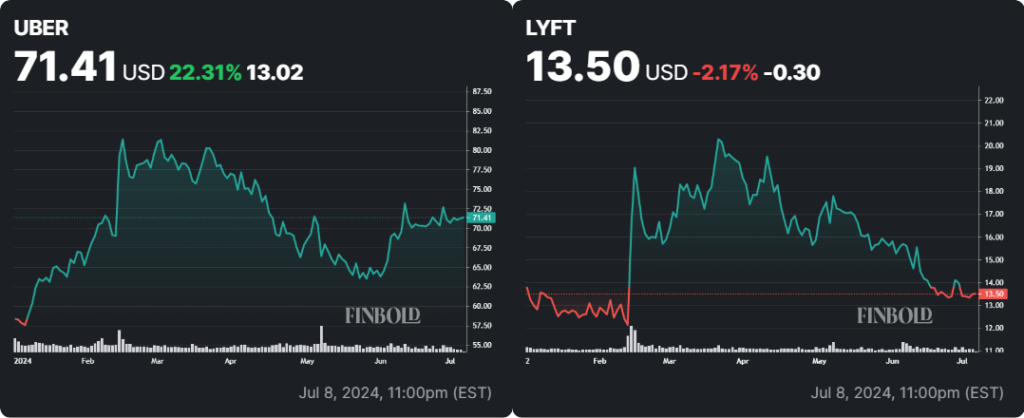Jefferies analysts believe Tesla (NASDAQ: TSLA) and other autonomous vehicle (AV) developers may find their most efficient path to market by partnering with established ridesharing companies like Uber (NYSE: UBER) and Lyft (NASDAQ: LYFT).
Uber and Lyft stocks tell a tale of two varying performances, with one dominating the ride-hailing industry and the other capturing only a fraction of the market share. UBER has gained 22% on a year-to-date (YTD) basis, while LYFT stock has lost 2.32% over the same period.
As of the latest close, UBER stock was trading at $71.25 after a positive daily gain of 0.27%, while LYFT stock closed yesterday’s trading session at $13.48 with a 1.13% gain.

Their research highlights several key reasons for this conclusion, emphasizing such collaborations’ economic and operational benefits for their stocks. Jefferies’ survey and analysis of Robotaxi unit economics indicate strong consumer demand for Robotaxis, mainly when offered at a discount.
The survey revealed that 73% of U.S. rideshare users would consider a Robotaxi, with price being a significant factor in their decision.
Tesla and its partners stand to profit from cooperation
Jefferies found that partnering with Uber and Lyft offers significant economic advantages over operating a standalone fleet.
They estimate that gross profit per ride could be 22% higher for a Robotaxi fleet that partners with rideshare companies than an independent fleet. This is mainly because rideshare companies already possess established logistics and pricing expertise.
A Robotaxi partnership would allow these companies to leverage their existing high-utilization fleets, optimizing operations and increasing profitability.
Additionally, integrating with rideshare platforms would facilitate better market penetration and customer acquisition.
Potential drawbacks and advantages of cooperation
Insurance costs are another critical factor in the economics of Robotaxi fleets. Jefferies estimates that insurance will be the most considerable expense for Robotaxi fleets, and standalone fleets with lower utilization rates would face even higher insurance costs per ride.
Tesla and other AV developers could significantly reduce these costs by partnering with rideshare providers. Jefferies concludes that for both Tesla and General Motors (NYSE: GM) stocks, “a partnership with rideshare providers looks to be the most logical approach.”
Tesla’s planned August 8 event is expected to unveil its Robotaxi strategy. Jefferies suggests that its low-cost Tesla Network concept could be most efficient when combined with rideshare for additional capacity. This approach could streamline Tesla’s market entry and enhance its competitive edge in the burgeoning autonomous vehicle sector.
Buy stocks now with eToro – trusted and advanced investment platform
Disclaimer: The content on this site should not be considered investment advice. Investing is speculative. When investing, your capital is at risk.










